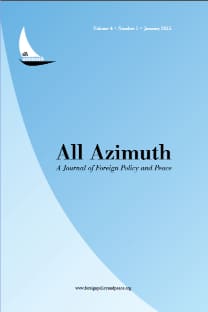Intelligence Cooperation in the European Union: An Impossible Dream?
Intelligence Cooperation in the European Union: An Impossible Dream?
Intelligence, European Union, intelligence organizations, intelligence cooperation terrorism,
___
- van Buuren, Jelle. Secret Truth. The EU Joint Situation Centre. Amsterdam: Eurowatch, 2009.
- Clerix, Kristof. “Ilkka Salmi, the EU’s Spymaster.” Mondiaal Nieuws. Accessed May 24, 2014. http://www.mo.be/ node/3789.
- Cross, Davis Mai’a K. “EU Intelligence Sharing and Joint Situation Centre: A Glass Half-Full.” Paper prepared for delivery at the Meeting of the European Studies Association, 2011. Accessed May 24, 2014. http://www.euce. org/eusa/2011/papers/3a_cross.pdf.
- ––– . “A European Transgovernmental Intelligence Network and the Role of IntCen.” Perspectives on European
- Cross, “European Transgovernmental Intelligence.”
- Politi, “European Intelligence Necessary?” Politics and Society 14, no. 3 (2013): 388-402.
- European Union Law. Military Staff of the European Union. Accessed August 17, 2010, http://europa.eu/legislation_ summaries/foreign_and_security_policy/cfsp_and_esdp_implementation/r00006_en.htm.
- European Union External Action. “The European Union Satellite Centre.” Accessed May 25, 2014. http://www.eeas. europa.eu/csdp/structures-instruments-agencies/eu-agencies-on-csdp/eu-satellite-centre/index_en.htm.
- European Union Military Staff. “Providing Military Capabilities to the EU.” Accessed August 20, 2010. http://www. consilium.europa.eu/uedocs/cmsUpload/EUMS-June-2010.pdf.
- Jones, Chris. “Analysis: Secrecy Reigns at the EU’s Intelligence Centre.” Statewatch 22, no. 4 (2013). Accessed May 24, 2014. http://www.statewatch.org/analyses/no-223-eu-intcen.pdf.
- Lefebvre, Stéphane. “The Difficulties and Dilemmas of International Intelligence Cooperation.”International Journal of Intelligence and Counterintelligence 16, no. 4 (2003): 527 -542.
- Lemieux, Frederic. “Information Technology and Criminal Intelligence: A Comparative Perspective.” In Technocrime: Technology, Crime and Social Control, edited by Stephane Leman-Langlois, 139-68. Willan Publishing: London, 2013.
- Müller-Wille, Björn. “The Effect of International Terrorism on EU Intelligence Co-operation.” JCMS 46, no.1 (2008): 49-73.
- ––– . “EU Intelligence Co-operation. A Critical Analysis.” Contemporary Security Policy 23, no. 2 (2002): 61-86.
- Nomikos, John. “Does the European Union Need a Common Intelligence Policy?” Accessed August 18, 2010. http:// www.worldsecuritynetwork.com/showArticle3.cfm?article_id=8661.
- ––– . “European Union Intelligence Agency: A Necessary Institution for Common Intelligence Policy?” In Contemporary Issues and Debates in EU Policy: The European Union and International Relations, edited by Vassiliki N. Koutrakou. Manchester University Press: Manchester, 2004.
- Politi, Alessandro. “Why is a European Intelligence Necessary?” In Towards a European Intelligence Policy, edited by Alessandro Politi. Institute for Security Studies, 1998.
- Schreier, Fred. WMD Proliferation: Reforming the Security Sector to Meet the Threat. Virginia: Potomac Books, 2009.
- Walsh, I. James. “Intelligence Sharing in the European Union: Institutions Are Not Enough.” JCMS 44, no. 3 (2006): 625-43.
- ISSN: 2146-7757
- Yayın Aralığı: 2
- Başlangıç: 2012
- Yayıncı: Dış Politika ve Barış Araştırmaları Merkezi, İhsan Doğramacı Barış Vakfı
Peace Education: Training for an Evolved Consciousness of Non-violence
Conflict Resolution Revisited: Peaceful Resolution, Mediation and Responsibility to Protect
Peace Education as a Post-conflict Peacebuilding Tool1
Non-Western International Relations Theory and Ibn Khaldun
Intelligence Cooperation in the European Union: An Impossible Dream?
